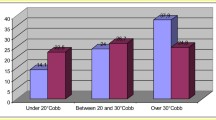Abstract
The purpose of this lecture was to give an overview of the natural history of adolescent idiopathic scoliosis (AIS), in order to serve as guidance in the decision of performing surgery or not for the specific patient with AIS. A literature review was performed. Studies concerning long-term outcome in patients with adolescent idiopathic scoliosis that had received no treatment were used. Outcome in terms of curve size, pulmonary function, back function and quality or life/social life was compared. The literature review showed that single thoracic curves of 50°–75° progress 0.73°/year over a 40-year period. AIS do not result in increased mortality, but pulmonary symptoms may be associated with larger curves. Back pain is more frequent among patients with AIS. No study using modern quality of life questionnaires exists, but for social function, childbearing, and marriage no apparent disadvantageous effects were reported compared to the healthy population. The conclusion is that most individuals with AIS and moderate curve size around maturity function well and lead an acceptable life in terms of work and family. Some patients with larger curves have pulmonary problems, but not to the extent that this affects the life span. This needs to be taken into account when discussing surgery with the individual patient.

Similar content being viewed by others
References
Nilsonne U, Lundgren KD (1968) Long-term prognosis in idiopathic scoliosis. Acta Orthop Scand 39:456–465
Nachemson A (1968) A long term follow-up study of non-treated scoliosis. Acta Orthop Scand 39:466–476
Pehrsson K, Bake B, Larsson S et al (1991) Lung function in adult idiopathic scoliosis: a 20 year follow up. Thorax 46:474–478
Pehrsson K, Larsson S, Oden A et al (1992) Long-term follow-up of patients with untreated scoliosis. A study of mortality, causes of death, and symptoms. Spine 17:1091–1096
Collis DK, Ponseti IV (1969) Long-term follow-up of patients with idiopathic scoliosis not treated surgically. J Bone Joint Surg [Am] 51:425–445
Weinstein SL, Zavala DC, Ponseti IV (1981) Idiopathic scoliosis: long-term follow-up and prognosis in untreated patients. J Bone Joint Surg [Am] 63:702–712
Weinstein SL, Dolan LA, Spratt KF et al (2003) Health and function of patients with untreated idiopathic scoliosis: a 50-year natural history study. JAMA 289:559–567
Ascani E, Bartolozzi P, Logroscino CA (1986) Natural history of untreated idiopathic scoliosis after skeletal maturity. Spine 11:784–789
Edgar MA (1987) The natural history of unfused scoliosis. Orthopedics 10:931–939
Edgar MA, Mehta MH (1988) Long-term follow-up of fused and unfused idiopathic scoliosis. J Bone Joint Surg [Br] 70:712–716
Author information
Authors and Affiliations
Corresponding author
About this article
Cite this article
Danielsson, A.J. Natural history of adolescent idiopathic scoliosis: a tool for guidance in decision of surgery of curves above 50°. J Child Orthop 7, 37–41 (2013). https://doi.org/10.1007/s11832-012-0462-7
Received:
Accepted:
Published:
Issue Date:
DOI: https://doi.org/10.1007/s11832-012-0462-7




